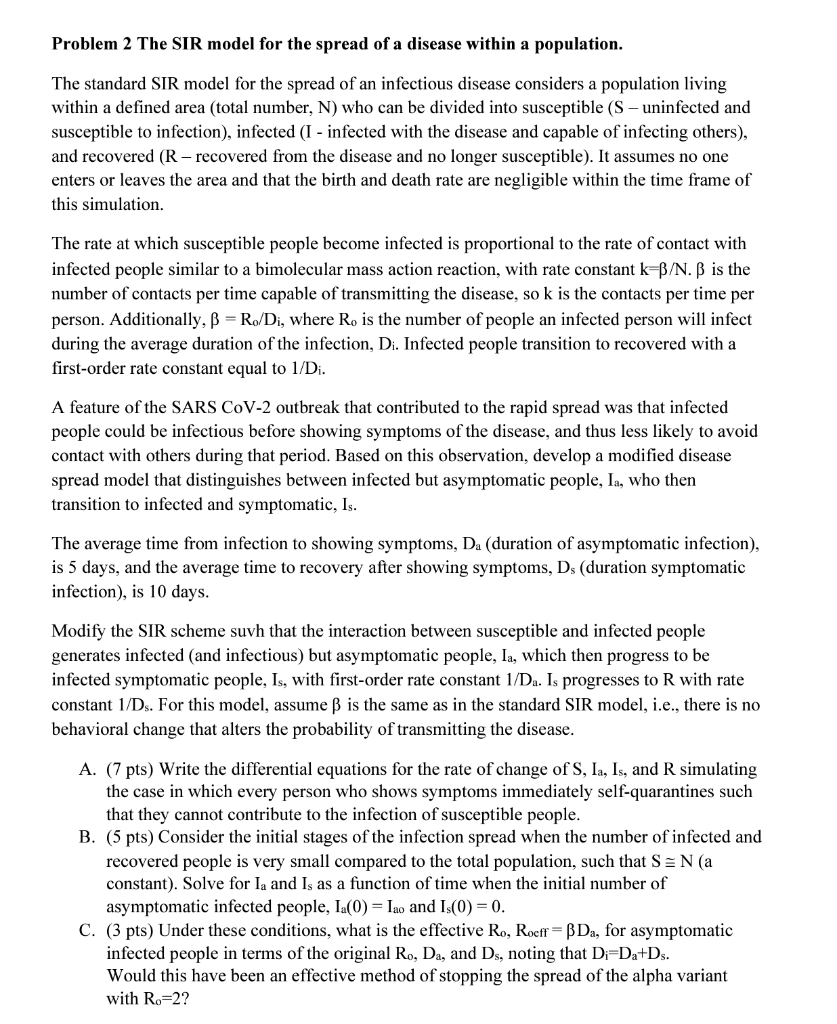
Problem 2 The SIR model for the spread of a disease within a population. The standard SIR model for the spread of an infectious disease considers a population living within a defined area (total number, N ) who can be divided into susceptible ( S - uninfected and susceptible to infection), infected (I - infected with the disease and capable of infecting others), and recovered ( R - recovered from the disease and no longer susceptible). It assumes no one enters or leaves the area and that the birth and death rate are negligible within the time frame of this simulation. The rate at which susceptible people become infected is proportional to the rate of contact with infected people similar to a bimolecular mass action reaction, with rate constant k=/N. is the number of contacts per time capable of transmitting the disease, so k is the contacts per time per person. Additionally, =R0/Di, where R0 is the number of people an infected person will infect during the average duration of the infection, Di. Infected people transition to recovered with a first-order rate constant equal to 1/Di. A feature of the SARS CoV-2 outbreak that contributed to the rapid spread was that infected people could be infectious before showing symptoms of the disease, and thus less likely to avoid contact with others during that period. Based on this observation, develop a modified disease spread model that distinguishes between infected but asymptomatic people, Ia, who then transition to infected and symptomatic, Is. The average time from infection to showing symptoms, Da (duration of asymptomatic infection), is 5 days, and the average time to recovery after showing symptoms, Ds (duration symptomatic infection), is 10 days. Modify the SIR scheme suvh that the interaction between susceptible and infected people generates infected (and infectious) but asymptomatic people, Ia, which then progress to be infected symptomatic people, Is, with first-order rate constant 1/D Da. Is progresses to R with rate constant 1/D s. For this model, assume is the same as in the standard SIR model, i.e., there is no behavioral change that alters the probability of transmitting the disease. A. (7 pts) Write the differential equations for the rate of change of S,Ia, Is, and R simulating the case in which every person who shows symptoms immediately self-quarantines such that they cannot contribute to the infection of susceptible people. B. (5 pts) Consider the initial stages of the infection spread when the number of infected and recovered people is very small compared to the total population, such that SN (a constant). Solve for Ia and Is as a function of time when the initial number of asymptomatic infected people, Ia(0)=Iao and Is(0)=0. C. (3 pts) Under these conditions, what is the effective Ro,Roeff=Da, for asymptomatic infected people in terms of the original R0,Da, and Ds, noting that Di=Da+Ds. Would this have been an effective method of stopping the spread of the alpha variant with R0=2







